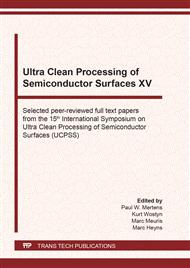p.253
p.259
p.264
p.270
p.277
p.282
p.289
p.295
p.302
Removal of Post Etch Residue on BEOL Low-K with Nanolift
Abstract:
Particle removal from BEOL low-k structures is studied using a novel particle removal technique, called Nanolift which removes particles from the substrate by forming a thin polymer film on the surface and removing the polymer film together with the particles. It was confirmed that Nanolift is capable to remove TiFx particles successfully which are generated during the low-k dry etch process for dual damascene structure formation for BEOL interconnect fabrication. Pattern collapse of the fragile low-k structure was confirmed to be prevented by Nanolift in comparison with conventional dual fluid spray cleaning method. FTIR results show that Nanolift leaves no residual polymer remain in low-k films and K-value shift by the Nanolift process was negligible and comparable with the conventional formulated chemistry cleaning process. From these results, Nanolift can be concluded as a suitable cleaning process for advanced BEOL fabrication process.
Info:
Periodical:
Pages:
277-281
Citation:
Online since:
February 2021
Authors:
Keywords:
Price:
Сopyright:
© 2021 Trans Tech Publications Ltd. All Rights Reserved
Share:
Citation:


